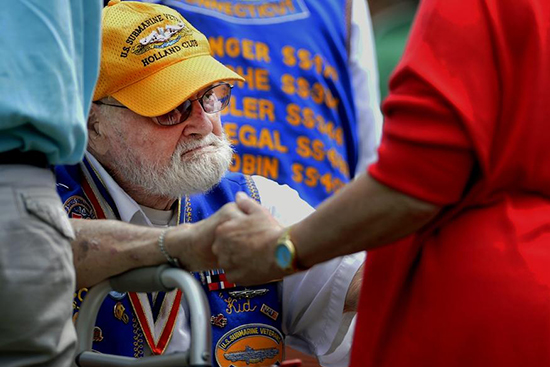Ledyard — While he was held for three years as a prisoner of war during World War II, Ernest Plantz was fed rice with bits of dead worms and beaten when he was too exhausted to work.
“At one point I held the record for beatings by a baseball bat,” the 86-year-old Gales Ferry resident remembered. “I was struck 75 times in one day.”
Plantz, then 21, was an electrician 3rd class aboard the USS Perch when a Japanese convoy attacked the submarine in the Java Sea on March 1, 1942. When the submarine’s commander, who had been aboard with five officers and 54 sailors, ordered the Perch scuttled, Plantz figured that was the last he’d see of the submarine.
“Seeing the sub go down was like seeing my home go down,” Plantz explained.
This past Thanksgiving Day the Perch was discovered 190 feet below the surface by an Australian team hoping to take photos of the wreck of the British cruiser HMS Exeter.
“I was surprised,” Plantz said, “I never thought I’d see it again.”
Last week the frail but sharp-witted Plantz sifted through the expedition’s pictures of the submarine in his living room. Plantz was struck by a photograph of a large hole where a Japanese shell barreled through the hull.
“Fortunately for us it didn’t explode,” Plantz said.
When Plantz first saw the photos, he said that memories came flooding back to him.
“They reminded me of the beginning of that horrible time,” he said. “I think they bring back more bad memories than good.”
After being captured by the Japanese, Plantz and his shipmates were held on Makassar, an island in what is now Indonesia. In what would be Plantz’s final year at the camp in 1945, six of his shipmates died from torture, disease, and malnourishment.
When the 180-pound Plantz emerged from the prison, he weighed 80 pounds and was near death. He suffered from starvation, malaria and dysentery.
Still, not all of Plantz’s memories upon seeing the photos of the wreck were bad ones. Looking at a shot of a glass porthole, Plantz was instantly nostalgic.
“I loved sitting there when we submerged, watching the fish go by,” he recalled.
Since the Perch was discovered, Plantz has been in contact with two of the ship’s five living survivors — Robert Lents and Marion “Turk” Turner, who Plantz has been close with since their ordeal.
“They were all so excited,” said Plantz’s wife Caroline about some of the men’s conversations.
Caroline said that her husband now wonders if his bolo knife, a prized possession, is still in his locker on the Perch. The knife is a type of machete used in the jungles of Indonesia and the Philippines.
“I was quite proud of it,” Ernest Plantz explained, “I almost took it off the ship.”
Had Plantz taken the knife off the submarine, he likely would have been killed.
“They stripped a person of everything he had in his pockets,” he said.
Charles Hinman, education director at the USS Bowfin Submarine Museum in Honolulu, Hawaii, said that fellow survivor Lents had a similar curiosity, jokingly wondering about the $37 he left on board.
Hinman and the museum were the first to report the findings, and he has been in touch with Plantz, e-mailing him photos of the Perch.
Hinman said that the Perch wreckage is unique when compared to other lost submarines.
“Perch’s case is different because no men were lost when the boat went down,” he said.
During World War II about 288 submarines were deployed, 158 of which saw combat. Fifty-two of these vessels were lost at sea, most often in the Pacific. Only 10 of those have been located.
The Naval Historical Center in Washington, D.C. is now responsible for making the Perch findings official, though there is little doubt that the submarine is, in fact, the USS Perch. A plaque with the submarine’s name still rests on the wreckage.
Of the approximately 37 World War II submarine POWs alive today, five are from the Perch, according to Art Randall, regional director of U.S. Submarine Veterans Inc. John Carcioppolo, local Groton base commander of U.S. Subvets, Inc., said that fewer than 3,000 living World War II submarine veterans remain.
Randall has been working on compiling short biographies of POWs like Plantz.
“We’re losing them every day,” he said.
This article originally appeared in The Day.
